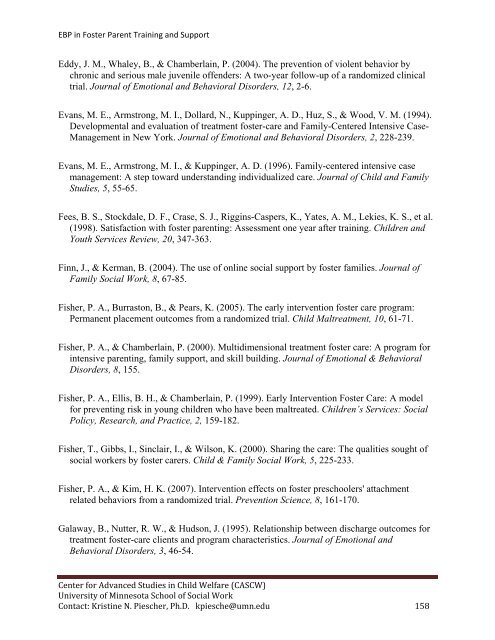Evidence-Based Practice in Foster Parent Training and Support ...
Evidence-Based Practice in Foster Parent Training and Support ...
Evidence-Based Practice in Foster Parent Training and Support ...
Create successful ePaper yourself
Turn your PDF publications into a flip-book with our unique Google optimized e-Paper software.
EBP <strong>in</strong> <strong>Foster</strong> <strong>Parent</strong> Tra<strong>in</strong><strong>in</strong>g <strong>and</strong> <strong>Support</strong>Eddy, J. M., Whaley, B., & Chamberla<strong>in</strong>, P. (2004). The prevention of violent behavior bychronic <strong>and</strong> serious male juvenile offenders: A two-year follow-up of a r<strong>and</strong>omized cl<strong>in</strong>icaltrial. Journal of Emotional <strong>and</strong> Behavioral Disorders, 12, 2-6.Evans, M. E., Armstrong, M. I., Dollard, N., Kupp<strong>in</strong>ger, A. D., Huz, S., & Wood, V. M. (1994).Developmental <strong>and</strong> evaluation of treatment foster-care <strong>and</strong> Family-Centered Intensive Case-Management <strong>in</strong> New York. Journal of Emotional <strong>and</strong> Behavioral Disorders, 2, 228-239.Evans, M. E., Armstrong, M. I., & Kupp<strong>in</strong>ger, A. D. (1996). Family-centered <strong>in</strong>tensive casemanagement: A step toward underst<strong>and</strong><strong>in</strong>g <strong>in</strong>dividualized care. Journal of Child <strong>and</strong> FamilyStudies, 5, 55-65.Fees, B. S., Stockdale, D. F., Crase, S. J., Rigg<strong>in</strong>s-Caspers, K., Yates, A. M., Lekies, K. S., et al.(1998). Satisfaction with foster parent<strong>in</strong>g: Assessment one year after tra<strong>in</strong><strong>in</strong>g. Children <strong>and</strong>Youth Services Review, 20, 347-363.F<strong>in</strong>n, J., & Kerman, B. (2004). The use of onl<strong>in</strong>e social support by foster families. Journal ofFamily Social Work, 8, 67-85.Fisher, P. A., Burraston, B., & Pears, K. (2005). The early <strong>in</strong>tervention foster care program:Permanent placement outcomes from a r<strong>and</strong>omized trial. Child Maltreatment, 10, 61-71.Fisher, P. A., & Chamberla<strong>in</strong>, P. (2000). Multidimensional treatment foster care: A program for<strong>in</strong>tensive parent<strong>in</strong>g, family support, <strong>and</strong> skill build<strong>in</strong>g. Journal of Emotional & BehavioralDisorders, 8, 155.Fisher, P. A., Ellis, B. H., & Chamberla<strong>in</strong>, P. (1999). Early Intervention <strong>Foster</strong> Care: A modelfor prevent<strong>in</strong>g risk <strong>in</strong> young children who have been maltreated. Children’s Services: SocialPolicy, Research, <strong>and</strong> <strong>Practice</strong>, 2, 159-182.Fisher, T., Gibbs, I., S<strong>in</strong>clair, I., & Wilson, K. (2000). Shar<strong>in</strong>g the care: The qualities sought ofsocial workers by foster carers. Child & Family Social Work, 5, 225-233.Fisher, P. A., & Kim, H. K. (2007). Intervention effects on foster preschoolers' attachmentrelated behaviors from a r<strong>and</strong>omized trial. Prevention Science, 8, 161-170.Galaway, B., Nutter, R. W., & Hudson, J. (1995). Relationship between discharge outcomes fortreatment foster-care clients <strong>and</strong> program characteristics. Journal of Emotional <strong>and</strong>Behavioral Disorders, 3, 46-54.Center for Advanced Studies <strong>in</strong> Child Welfare (CASCW)University of M<strong>in</strong>nesota School of Social WorkContact: Krist<strong>in</strong>e N. Piescher, Ph.D. kpiesche@umn.edu 158
















